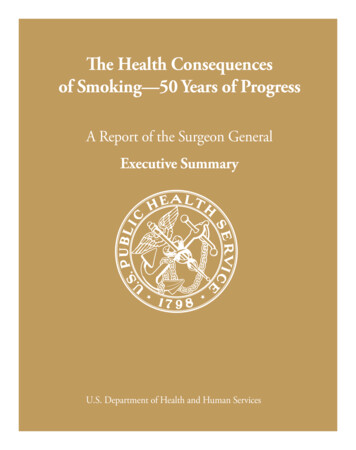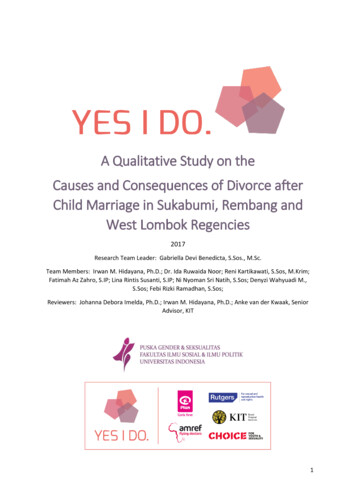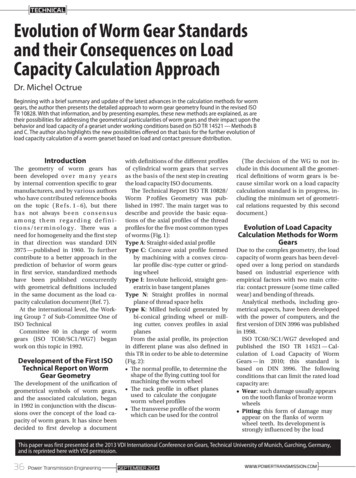
Transcription
The Health Consequencesof Smoking—50 Years of ProgressA Report of the Surgeon GeneralExecutive SummaryU.S. Department of Health and Human Services
The Health Consequences ofSmoking —50 Years of ProgressA Report of the Surgeon GeneralExecutive Summary2014U.S. DEPARTMENT OF HEALTH AND HUMAN SERVICESPublic Health ServiceOffice of the Surgeon GeneralRockville, MD
Suggested CitationU.S. Department of Health and Human Services. The Health Consequences of Smoking —50 Yearsof Progress: A Report of the Surgeon General. Atlanta, GA: U.S. Department of Health and HumanServices, Centers for Disease Control and Prevention, National Center for Chronic Disease Preventionand Health Promotion, Office on Smoking and Health, 2014.For more informationFor more information about the Surgeon General’s report, visit www.surgeongeneral.gov.To download copies of this document, go to www.cdc.gov/tobacco.To order copies of this document, go to www.cdc.gov/tobacco and click on Publications Catalog or call1-800-CDC-INFO (1-800-232-4636); TTY: 1-888-232-6348.Use of trade names is for identification only and does not constitute endorsement by theU.S. Department of Health and Human Services. Any recommendations expressed bynon-governmental individuals or organizations do not necessarily represent the views or opinionsof the U.S. Department of Health and Human Services.
Message from Kathleen SebeliusSecretary of Health and Human ServicesFifty years after the release of the first Surgeon General’s report warning of the health hazardsof smoking, we have learned how to end the tobacco epidemic. Over the past five decades, scientists,researchers and policy makers have determined what works, and what steps must be taken if we trulywant to bring to a close one of our nation’s most tragic battles—one that has killed ten times the number of Americans who died in all of our nation’s wars combined.In the United States, successes in tobacco control have more than halved smoking rates since the1964 landmark Surgeon General’s report came out. Americans’ collective view of smoking has beentransformed from an accepted national pastime to a discouraged threat to individual and public health.Strong policies have largely driven cigarette smoking out of public view and public air space. Thanks tosmokefree laws, no longer is smoking allowed on airplanes or in a growing number of restaurants, bars,college campuses and government buildings.Evidence in this new report shows tobacco’s continued, immense burden to our nation—and howessential ending the tobacco epidemic is to our work to increase the life expectancy and quality of life ofall Americans. This year alone, nearly one-half million adults will still die prematurely because of smoking. Annually, the total economic costs due to tobacco are now over 289 billion. And if we continueon our current trajectory, 5.6 million children alive today who are younger than 18 years of age will dieprematurely as a result of smoking.I believe that we can make the next generation tobacco-free. And I am extremely proud of theObama Administration’s tobacco-control record. For example, the 2009 Children’s Health InsuranceProgram Reauthorization Act included an unprecedented 0.62 tax increase that raised the federalexcise tax to 1.01 per pack of cigarettes; we know that increasing the cost of cigarettes is one of themost powerful interventions we can make to prevent smoking and reduce prevalence. Building onthis knowledge, the President’s Fiscal Year 2014 Budget includes a 0.94 per pack Federal tobacco taxincrease. For the first time in history, the 2009 Family Smoking Prevention and Tobacco Control Act(Tobacco Control Act) gave the U.S. Food and Drug Administration comprehensive authority to regulate tobacco products, which will play a critical role in reducing the harm caused by these products.The Tobacco Control Act also provided for user fees to be paid by tobacco manufacturers that can support sustained public education media campaigns targeting youth prevention and cessation. The 2010Affordable Care Act (ACA) expands access to smoking cessation services and now requires most insurance companies to cover cessation treatments. The Affordable Care Act’s Public Health and PreventionFund is supporting innovative and effective community-based programs as well as public educationcampaigns promoting prevention and helping people to quit.All of these tobacco control interventions are known to reduce tobacco use and, as a result,tobacco’s extraordinary toll of death and disease. But in order to free the next generation from theseburdens, we must redouble our tobacco control efforts and enlist nongovernmental partners—andsociety as a whole—to share in this responsibility. Ending the devastation of tobacco-related illness anddeath is not in the jurisdiction of any one entity. We must all share in this most worthwhile effort toend the tobacco epidemic.
Message from Howard KohAssistant Secretary for HealthThe nation stands poised at the crossroads of tobacco control. On one hand, we can celebratetremendous progress 50 years after the landmark 1964 Surgeon General’s report: Smoking and Health.Adult smoking rates have fallen from about 43% (1965) to about 18% today. Mortality rates from lungcancer, the leading cause of cancer death in this country, are declining. Most smokers visiting healthcare settings are now routinely asked and advised about tobacco use. On the other hand, cigarettesmoking remains the chief preventable killer in America, with more than 40 million Americans caughtin a web of tobacco dependence. Each day, more than 3,200 youth (younger than 18 years of age) smoketheir first cigarette and another 2,100 youth and young adults who are occasional smokers progress tobecome daily smokers. Furthermore, the range of emerging tobacco products complicates the currentpublic health landscape.In this context, the 50th Anniversary of the Surgeon General’s report prompts us to pause andask why this addiction persists when proven interventions can eliminate it. Of great concern, too manyin our nation assume that past success in tobacco control guarantees future progress; nothing can befurther from the truth. To rejuvenate and reinvigorate national efforts, in 2010, the U.S. Departmentof Health and Human Services unveiled its first ever strategic plan for tobacco control. Ending theTobacco Epidemic: A Tobacco Control Strategic Action Plan provides a critical framework to guideefforts to rapidly drop prevalence rates of smoking among youth and adults. A major foundation andpillar of the plan is to encourage and promote leadership throughout all sectors of society. Now, thiscurrent 2014 Surgeon General’s report can accelerate that leadership to fully implement the life-savingprevention that can make the next generation free of tobacco-related death and disease.We have many tools that we know work. A comprehensive public policy approach emphasizingmass media campaigns to encourage prevention and quit attempts, smokefree policies, restrictions onyouth access to tobacco products, and price increases can collectively drive further meaningful reductions in tobacco use. Furthermore, we can accelerate progress through full commitment to clinicaland public health advances; including the widespread use of telephone quit lines and science-basedcounseling and medications for tobacco users. Promoting progress today also requires recognizing thattobacco use has evolved from being an equal-opportunity killer to one threatening the most vulnerablemembers of our society. We must confront, and reverse, the tragically higher tobacco use rates thatthreaten persons of low socioeconomic status, sexual minorities, high school dropouts, some racial/ethnic minority groups, and those living with mental illness and substance use disorders.Of all the accomplishments of the 20th century, historians rank the 1964 Surgeon General’sreport as one of the seminal public health achievements of our time. Armed with both science andresolve, we can continue to honor the legacy of the report by completing the work it began in the lastcentury. The current 2014 Surgeon General’s report represents a national vision for getting the jobdone. With strategy, commitment, and action, our nation can leave the crossroads and move forward toend the tobacco epidemic once and for all.
ForewordFifty years have passed since publication of the landmark report of the Surgeon General’sAdvisory Committee on smoking and health. This report highlights both the dramatic progressour nation has made reducing tobacco use and the continuing burden of disease and death causedby smoking.As a physician, when I think about smoking, I recall the patients I have cared for. The man whohad a leg amputated. The woman who had to gasp for every single breath that she took. The man withheart disease who hoped to see his son graduate, but didn’t live long enough to do so. That’s the realityof smoking that health care providers see every day.The prevalence of current cigarette smoking among adults has declined from 42% in 1965 to 18%in 2012. However, more than 42 million Americans still smoke. Tobacco has killed more than 20 millionpeople prematurely since the first Surgeon General’s report in 1964. The findings in this report showthat the decline in the prevalence of smoking has slowed in recent years and that burden of smokingattributable mortality is expected to remain at high and unacceptable levels for decades to come unlessurgent action is taken.Recent surveys monitoring trends in tobacco use indicate that more people are using multipletobacco products, particularly youth and young adults. The percentage of U.S. middle and high schoolstudents who use electronic, or e-cigarettes, more than doubled between 2011 and 2012. We need tomonitor patterns of use of an increasingly wide array of tobacco products across all of the diverse segments of our society, particularly because the tobacco industry continues to introduce and market newproducts that establish and maintain nicotine addiction.Tobacco control efforts need to not only address the general population, but also to focus onpopulations with a higher prevalence of tobacco use and lower rates of quitting. These populationsinclude people from some racial/ethnic minority groups, people with mental illness, lower educationallevels and socioeconomic status, and certain regions of the country. We now have proven interventionsand policies to reduce tobacco initiation and use among youth and adults.With intense use of proven interventions, we can save lives and reduce health care costs. In 2012,the Centers for Disease Control and Prevention (CDC) launched the first-ever paid national tobaccoeducation campaign — Tips From Former Smokers (Tips) — to raise awareness of the harms to healthcaused by smoking, encourage smokers to quit, and encourage nonsmokers to protect themselves andtheir families from exposure to secondhand smoke. It pulled back the curtain in a way that numbersalone cannot, and showed the tobacco-caused tragedies that we as health care professionals see andare saddened by every day. As a result of this campaign, an estimated 1.6 million smokers made anattempt to quit and, based on a conservative estimate, at least 100,000 smokers quit for good. Additionally, millions of nonsmokers talked with friends and family about the dangers of smoking and referredsmokers to quit services. In 2013, CDC launched a new round of advertisements that helped even morepeople quit smoking by highlighting the toll that smoking-related illnesses take on smokers and theirloved ones.CDC has also established reducing tobacco use as one of its “Winnable Battles.” These are publichealth priorities with large-scale impact on health that have proven effective strategies to address them.CDC believes that with additional effort and support for evidence-based, cost-effective policy and program strategies to reduce tobacco use, we can reduce smoking substantially, prevent millions of peoplefrom being killed by tobacco, and protect future generations from smoking.i
While we have made tremendous progress over the past 50 years, sustained and comprehensiveefforts are needed to prevent more people from having to suffer the pain, disability, disfigurement, anddeath that smoking causes. Most Americans who have ever smoked have already quit, and most smokerswho still smoke want to quit. If we continue to implement tobacco prevention and cessation strategiesthat have proven effective in reducing tobacco use, people throughout our country will live longer,healthier, more productive lives.Thomas R. Frieden, M.D., M.P.H.DirectorCenters for Disease Control and Preventionii
Prefacefrom the Acting Surgeon General,U.S. Department of Health and Human ServicesOn January 11, 1964, Luther L. Terry, M.D., the 9th Surgeon General of the United States, releasedthe first report on the health consequences of smoking: Smoking and Health: Report of the AdvisoryCommittee of the Surgeon General of the Public Health Service. That report marked a major step toreduce the adverse impact of tobacco use on health worldwide.Over the past 50 years, 31 Surgeon General’s reports have utilized the best available evidence toexpand our understanding of the health consequences of smoking and involuntary exposure to tobaccosmoke. The conclusions from these reports have evolved from a few causal associations in 1964 to arobust body of evidence documenting the health consequences from both active smoking and exposureto secondhand smoke across a range of diseases and organ systems.The 2004 report concluded that smoking affects nearly every organ of the body, and the evidencein this report provides even more support for that finding. A half century after the release of the firstreport, we continue to add to the long list of diseases caused by tobacco use and exposure to tobaccosmoke. This report finds that active smoking is now causally associated with age-related maculardegeneration, diabetes, colorectal cancer, liver cancer, adverse health outcomes in cancer patients andsurvivors, tuberculosis, erectile dysfunction, orofacial clefts in infants, ectopic pregnancy, rheumatoidarthritis, inflammation, and impaired immune function. In addition, exposure to secondhand smokehas now been causally associated with an increased risk for stroke.Smoking remains the leading preventable cause of premature disease and death in the UnitedStates. The science contained in this and prior Surgeon General’s reports provide all the informationwe need to save future generations from the burden of premature disease caused by tobacco use. However, evidence-based interventions that encourage quitting and prevent youth smoking continue tobe underutilized. This report strengthens our resolve to work together to accelerate and sustain whatworks—such as hard-hitting media campaigns, smokefree air policies, optimal tobacco excise taxes,barrier-free cessation treatment, and comprehensive statewide tobacco control programs funded atCDC-recommended levels. At the same time, we will explore “end game” strategies that support thegoal of eliminating tobacco smoking, including greater restrictions on sales. It is my sincere hope that50 years from now we won’t need another Surgeon General’s report on smoking and health, becausetobacco-related disease and death will be a thing of the past. Working together, we can make that visiona reality.Boris D. Lushniak, M.D., M.P.H.Rear Admiral, U.S. Public Health ServiceActing Surgeon GeneralU.S. Department of Health and Human Servicesiii
The Health Consequences of Smoking —50 Years of ProgressOverviewFor the United States, the epidemic of smokingcaused disease in the twentieth century ranks among thegreatest public health catastrophes of the century, whilethe decline of smoking consequent to tobacco controlis surely one of public health’s greatest successes. However, the current rate of progress in tobacco control is notfast enough, and much more needs to be done to end thetobacco epidemic. Unacceptably high levels of smokingattributable disease and death, and the associated costs,will persist for decades without changes in our approachto slowing and even ending the epidemic. If smokingpersists at the current rate among young adults in thiscountry, 5.6 million of today’s Americans younger than18 years of age are projected to die prematurely from asmoking-related illness (Chapter 12).More than 20 million Americans have died as aresult of smoking since the first Surgeon General’s reporton smoking and health was released in 1964 (Table 1)(Chapter 12). Most were adults with a history of smoking,but nearly 2.5 million were nonsmokers who died fromheart disease or lung cancer caused by exposure to secondhand smoke. Another 100,000 were babies who died ofsudden infant death syndrome (often referred to as SIDS)or complications from prematurity, low birth weight, orTable 1 Premature deaths caused by smoking andexposure to secondhand smoke, 1965–2014Cause of deathTotalSmoking-related cancers6,587,000Cardiovascular and metabolic diseases7,787,000Pulmonary diseases3,804,000Conditions related to pregnancy and birth108,000Residential fires86,000Lung cancers caused by exposure tosecondhand smoke263,000Coronary heart disease caused by exposure tosecondhand smoke2,194,000Total20,830,000Source: Centers for Disease Control and Prevention, NationalCenter for Chronic Disease Prevention and Health Promotion,Office on Smoking and Health, unpublished data.other conditions caused by parental smoking, particularlysmoking by the mother.As these figures illustrate, the harms caused by thehistoric patterns of tobacco use in the United States, andespecially by cigarette smoking, are staggering. More than10 times as many U.S. citizens have died prematurely fromcigarette smoking than have died in all the wars foughtby the United States during its history. Study after studyhas confirmed the magnitude of the harm caused to thehuman body by exposure to toxicants and carcinogensfound in tobacco smoke. Since 1964, the 31 previous Surgeon General’s reports have chronicled a still growingbut already conclusive body of evidence about the adverseimpact of tobacco use on human cells and organs and onoverall health. Health statistics show that all populationsare affected.Previous Surgeon General’s reports have trackedthe evolution of cigarettes into the current highly engineered, addictive, and deadly products containing thousands of chemicals that are harmful in themselves, butthe burning of tobacco produces the complex chemicalmixture of more than 7,000 compounds that cause a widerange of diseases and premature deaths as a result (U.S.Department of Health and Human Services [USDHHS]2010). Although the prevalence of smoking has declinedsignificantly over the past one-half century, the risks forsmoking-related disease and mortality have not. In fact,today’s cigarette smokers—both men and women—have amuch higher risk for lung cancer and chronic obstructivepulmonary disease (COPD) than smokers in 1964, despitesmoking fewer cigarettes (see Chapters 6, 7, and 11, andFigure 12.2 and Figure 13.16).The 2004 Surgeon General’s report showed thatsmoking impacts nearly every organ of the body (USDHHS 2004). The 2006 report concluded that the scientificevidence indicates that there is no risk-free level of exposure to secondhand smoke (USDHHS 2006). The new evidence in this report provides still more support for theseconclusions. Fifty years after the first report in 1964, it isstriking that the scientific evidence in this report expandsthe list of diseases and other adverse health effects causedby smoking and exposure of nonsmokers to tobaccosmoke. Figures 1.1A and 1.1B highlight these new findings and show that the disease risks are even greater thanpresented in previous reports. These new findings include: Liver cancer and colorectal cancer are added to thelong list of cancers caused by smoking;Executive Summary 1
Surgeon General’s ReportFigure 1AThe health consequences causally linked to smokingSource: USDHHS 2004, 2006, 2012.Note: The condition in red is a new disease that has been causally linked to smoking in this report. Exposure to secondhand smoke is a cause of stroke; Smoking increases the risk of dying from cancer andother diseases in cancer patients and survivors; Smoking is a cause of diabetes mellitus; and Smoking causes general adverse effects on the bodyincluding inflammation and it impairs immunefunction. Smoking is a cause of rheumatoid arthritis.Progress has been made in tobacco control. Duringthe 50 years since the 1964 report, approaches have movedfrom single measures, such as small text-only pack warnings, to implementing comprehensive control programs,2Executive Summaryincluding indoor smoking bans, support for cessation,restrictions on advertising and promotion, media campaigns, and tax hikes to raise prices (Chapters 2 and 14).Smoking rates have declined, as have mortality rates forsome diseases caused by smoking, such as heart diseaseand lung cancer for which smoking is the major cause.Nonetheless, between 2005–2009, smoking wasresponsible for more than 480,000 premature deathsannually among Americans 35 years of age and older(Chapter 12). More than 87% of lung cancer deaths, 61%of all pulmonary disease deaths, and 32% of all deathsfrom coronary heart disease were attributable to smokingand exposure to secondhand smoke. Additionally, if current trends continue 5.6 million U.S. youth who are currently younger than 18 years of age will die prematurelyduring adulthood from their smoking (Chapter 12).
The Health Consequences of Smoking —50 Years of ProgressFigure 1BThe health consequences causally linked to exposure to secondhand smokeSource: USDHHS 2004, 2006.Note: The condition in red is a new disease that has been causally linked to smoking in this report.Many of the findings in this report have particularrelevance to women who are current smokers. For thefirst time ever, they are as likely as men to die from manydiseases caused by smoking (Chapter 12). The relative riskfor dying from coronary heart disease among women 35years of age and older is now higher than for men. Becausethe risks for women have increased so much in the lastdecades, women who smoke now have about the samehigh risk of death from lung cancer as men.In addition to the impact that smoking has on healthand well-being, the nation pays enormous financial costsbecause of smoking. Productivity losses from prematuredeath alone now exceed 150 billion per year (Chapter 12).Additionally, the value of lost productivity due to premature deaths caused by exposure to secondhand smoke isnow estimated to be 5.6 billion per year. The annual costsof direct medical care of adults attributable to smoking arenow estimated to be over 130 billion (Chapter 12).This comprehensive report chronicles the devastating consequences of 50 years of tobacco use in theUnited States. It updates data on the numerous healtheffects resulting from smoking and exposure to secondhand smoke, and details public health trends, both favorable and unfavorable, in tobacco use. This report marksthe steady progress achieved in reducing the prevalence ofsmoking and validates tobacco control strategies that haveconsistently proven to be effective. It also examines strategies with the potential to eradicate the death and diseasecaused by the tobacco epidemic at long last, and identifies specific measures that should be taken immediately tomove smoking off its decades-old number one spot as thelargest single cause of preventable death and disease forthe citizens of the United States. Finally, the report documents that effective interventions are available and callsfor their full implementation.Executive Summary 3
Surgeon General’s ReportMajor Conclusions from the Report1.The century-long epidemic of cigarette smoking hascaused an enormous avoidable public health tragedy.Since the first Surgeon General’s report in 1964 morethan 20 million premature deaths can be attributed tocigarette smoking.2.The tobacco epidemic was initiated and has beensustained by the aggressive strategies of the tobaccoindustry, which has deliberately misled the public onthe risks of smoking cigarettes.3.Since the 1964 Surgeon General’s report, cigarettesmoking has been causally linked to diseases of nearlyall organs of the body, to diminished health status,and to harm to the fetus. Even 50 years after thefirst Surgeon General’s report, research continues tonewly identify diseases caused by smoking, includingsuch common diseases as diabetes mellitus, rheumatoid arthritis, and colorectal cancer.4.5.Exposure to secondhand tobacco smoke has beencausally linked to cancer, respiratory, and cardiovascular diseases, and to adverse effects on the health ofinfants and children.The disease risks from smoking by women have risensharply over the last 50 years and are now equal tothose for men for lung cancer, chronic obstructivepulmonary disease, and cardiovascular diseases.6.In addition to causing multiple diseases, cigarettesmoking has many adverse effects on the body, suchas causing inflammation and impairing immunefunction.7.Although cigarette smoking has declined significantly since 1964, very large disparities in tobacco useremain across groups defined by race, ethnicity, educational level, and socioeconomic status and acrossregions of the country.8.Since the 1964 Surgeon General’s report, comprehensive tobacco control programs and policies havebeen proven effective for controlling tobacco use.Further gains can be made with the full, forceful, andsustained use of these measures.9.The burden of death and disease from tobacco use inthe United States is overwhelmingly caused by cigarettes and other combusted tobacco products; rapidelimination of their use will dramatically reduce thisburden.10. For 50 years the Surgeon General’s reports on smoking and health have provided a critical scientific foundation for public health action directed at reducingtobacco use and preventing tobacco-related diseaseand premature death.The 2014 Surgeon General’s report is presented in three sections:Section 1: Historical Perspective, Overview, and Conclusions;Section 2: The Health Consequences of Active and Passive Smoking: The Evidence in 2014; andSection 3: Tracking and Ending the Epidemic.The following is a summary of the contents of each section.4Executive Summary
The Health Consequences of Smoking —50 Years of ProgressSection 1: Historical Perspective, Overview, and ConclusionsWhen Dr. Luther L. Terry released the first SurgeonGeneral’s report on smoking and health in January 1964,few could have anticipated the long-term impact it wouldhave on this nation’s health. The report reviewed morethan 7,000 research articles related to smoking and disease—the evidence considered dated to the early twentieth century but most came from the wave of research thatstarted at mid-century. The initial report concluded thatsmoking was associated with higher all-cause mortalityrates among men, was a cause of lung cancer and laryngeal cancer in men, was a probable cause of lung cancerin women, and was the most important cause of bronchitis (U.S. Department of Health, Education, and Welfare1964). News coverage of the report was extensive, and therelease of the report was ranked among the top news stories of the twentieth century (USA Today 1999).Nonetheless, public attitudes about smoking and itsadverse health effects were slow to change, and smokingdeclined slowly after the report. In 1964, more than onehalf of men and nearly one-third of women were regularsmokers; it took approximately 15 years for rates of smoking among men to drop by one-quarter or more (Chapter2). The scientific evidence helped to launch public healthcampaigns about the dangers of smoking. The tobaccoindustry attempted to counter these campaigns throughaggressive advertising. It used a variety of tactics to create doubt about the findings on smoking and health andlaunched marketing strategies that obscured the dangersof smoking by implying that certain cigarettes were saferthan others. In fact, rates of smoking among women actually increased in the years following the first SurgeonGeneral’s report.During the decades that followed, however, a number of local, state, and federal laws and policies addressedtobacco product marketing and advertising, labeling andpackaging, youth access, and exposure to secondhandsmoke. Social norms that had made smoking acceptableeverywhere began to change as a grassroots movementaimed at protecting nonsmokers emerged. Surgeon General’s reports on the impact of tobacco use on specificpopulations, the changing cigarette, nicotine addiction,specific smoking-related diseases, and secondhand smokegave impetus to a steady movement away from smokingas an acceptable social norm. The prevalence of smokingamong adults is now less than one-half of what it was in1964, and the prevalence among youth is less than onehalf. A 2011 Gallup poll reported that for the first time, amajority of Americans supported a ban on smoking in allpublic places (Newport 2011).The ongoing story of tobacco use covered in thisSurgeon General’s report illustrates the complexity anddynamic nature of the issue. This report examines smoking from a public health standpoint; as a cultural andsocial phenomenon; as an extension of the tobacco industry’s aggressive and fraudulent campaigns to mislead thepublic on health hazards; and from legal, policy, and public education perspectives.Section 2: The Health Consequences of Active and PassiveSmoking: The Evidence in 2014Since 1964, the evidence on smoking and healthhas expanded greatly; the list of adverse consequences oftobacco smoking has lengthened progressively; and sincethe 1970s, scientific research has linked the inhalation ofsecondha
youth access to tobacco products, and price increases can collectively drive further meaningful reduc-tions in tobacco use. Furthermore, we can accelerate progress through full commitment to clinical and public health advances; including the widespread use of telephone quit lines and science-based counseling and medications for tobacco users.











